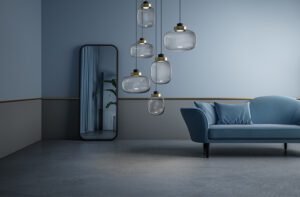David Hacin, Architect
March 23, 2009
Text by Stacy Kunstel Photography by David Carmack
David Hacin’s streamlined look shows up on the Boston landscape in the form of contemporary buildings and sleek retail stores. The Harvard-educated Hacin is interested in all facets of design, from architecture to furniture.
Stacy Kunstel, Homes Editor: What do you like best about working in Boston?
David Hacin: I love Boston because it's a great city with a unique sensibility. From a design sensibility it's more self-confident than in the past and is allowing for more experimentation. More interesting designers are emerging, and I think in the next few years more interesting architectural projects are going to be coming on line. Since I've been in Boston—almost twenty years now—the design scene just gets better and better.
SK: Are there enough resources in Boston for the type of work you do?
DH: It's getting better and better. I would like to put in a shameless plug for the Boston Design Center. I think with the emerging contemporary design district in Park Square and a lot of the smaller stores in the South End and then the Design Center, which has brought a lot of interesting showrooms to Boston, that there are really are a lot of resources here—more than ever before. The need to go to New York or other places to do research and shopping is less than it used to be in terms of interior design.
SK: As an architect, you take care of a lot of the interior design aspects of your work, something not a lot of architects feel comfortable with.
DH: If you look back in architectural history, many of the most notable architects have been interested in all aspects of design. Frank Lloyd Wright, Mies van der Rohe, Le Corbusier—they were as interested in furniture and materials and details as they were in the overall architectural project. When I first became interested in architecture I had that same interest. I still do. For me it's about design—and design can take on many forms. I can be designing a dining room table or the apartment that the dining room table is in, or it can be designing the building that the apartment is in. I'm interested in that entire range of design.
SK: Shouldn't there be a complete integration of interiors and architecture?
DH: I have a lot of respect for all of these designers—landscape designers, urban designers, interior designers, lighting designers. I'm a proponent of integrating all of the allied design professions. I think architects can and should take a leading role in bringing these people together. When that's done successfully, the results are fantastic.
SK: You're known for a certain look, but how do you describe your look?
DH: Clean would be one way to put it. Simplicity is difficult to achieve. I really do believe that simplicity is the ultimate sophistication. I respect a lot of other design approaches, but as the world gets busier, more chaotic, there's a serenity that can be derived from being in an environment that's been conceived in a very clear and legible way, where the focus is on light, materials and flow rather than decoration.
SK: Do you call yourself a modernist?
DH: I don't know what that means anymore, unfortunately. The principles of the modernist movement—which is a historical style now like any other—do resonate with me. But I would like to think that modernism as an idea is evolving along with the rest of society with the influences of technology, new materials and sustainability. Someday we'll look back on this period and define it another way.
SK: What will we call this time?
DH: Some people call this era sort of a neo-modern era, but I don't really like that term. I would say it's a very eclectic time right now. It's one of those moments in the history of architecture and design that so many things are vying for attention. If you look historically, many of the most exciting periods of design history have been moments of transition. I think we're in one of those moments of transition. The big issues of the day, like technology and sustainability, creating flexible spaces as we have less and less space to occupy, are all really big challenges. Time will tell where that takes us.
SK: Would you ever design a traditional space?
DH: No, never. There are people who do it better than I do because that's where their heart is and that's where there interests are. There's a long and rich tradition of stylistic revivals in this country that have yielded some of the most beautiful work—look at H.H. Richardson. He was a revivalist, he did Romanesque Revival and I think everyone would acknowledge that he was one of Boston's greatest architects. I respect that approach but it's not the challenge I'm personally interested in.
SK: What is your challenge?
DH: There are a number of challenges. I'm really interested in community and how architecture and design can have a big impact on building communities. That's certainly been true of my experience in the South End. Even though we work nationally and internationally, I feel very committed to Boston and to finding solutions that make sense here. I wouldn't want architecture and designers in Boston to look like architecture and design anywhere else. I think one of the challenges is to try to identify what contemporary Boston is and should be and how that should be reflected in architecture and design.
Share
![NEH-Logo_Black[1] NEH-Logo_Black[1]](https://b2915716.smushcdn.com/2915716/wp-content/uploads/2022/08/NEH-Logo_Black1-300x162.jpg?lossy=1&strip=1&webp=1)






